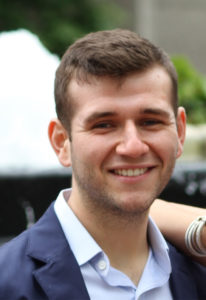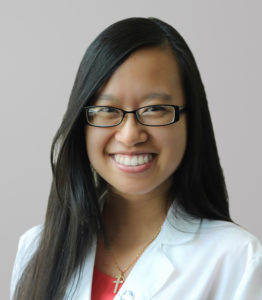2019 – 2020 T32 Fellows
Meet the 2019 – 2020 T32 Fellows
 |
Garen Anderson
|
| Preserving oxygen delivery to the brain during conditions of reduced blood flow is vital for preventing tissue damage and/or death. My research investigates how altering the pattern of blood flow may be beneficial to oxygen delivery to the brain during conditions with reduced blood flow. Early evidence suggests that inducing a wavelike or oscillatory pattern in blood flow may be protective to brain oxygenation. Exploring the mechanisms behind the observed benefits of oscillatory blood flow will help determine the possible utility of inducing oscillations in blood flow as a therapy for conditions such as blood loss or stroke recovery. | |
 |
Delaney Davis
|
| The focus of my research is on the effects of different interventions on the motor and cognitive function across the murine lifespan. My aims are: (1) To discover the role of glutathione, an important antioxidant and indicator of redox status, in aging and resiliency. This project may provide a new understanding to the updated redox stress theory of aging and to the potential, beneficial role of alternative pathways in glutathione production that could incur resiliency. (2) To evaluate if early, chronic methamphetamine exposure leads to long-term neurobehavioral consequences. This project will also examine the role of oxidative stress on long-term effects in a preclinical model of psychostimulant-imposed biological risk. | |
 |
Courtney Hall
|
| Advances in epigenetics have revealed that methylation patterns in both the nuclear and mitochondrial genomes vary across tissue types and with the age of an individual. Epigenetic modifications have been implicated in numerous neurobiological and cognitive processes, and thus may play a key role in the progression and pathology of age-related brain disorders, including dementia, Alzheimer’s disease, and Parkinson’s disease. Although this area of research has received increased attention in recent years, most of the resultant data are limited by the techniques utilized, namely bisulfite conversion. In light of these shortcomings, my current research is focused on the development of PCR-free enrichment strategies prior to single-molecule nanopore-based sequencing. Enrichment followed by nanopore sequencing ensures that target regions outcompete background noise for pore access, allowing for direct, long-range phasing of polymorphisms in gene regions as well as detection of epigenetic modifications. The ability to simultaneously assess nucleotide composition and methylation patterns could provide critical information in the context of the genetic and epigenetic features of age-related diseases and health disparities. Ultimately, this method will form the foundation for future research efforts aimed at identifying variation in the methylomes of healthy and diseased tissues across different regions of the brain. | |
 |
Holden Hemingway
|
| In the Human Vascular Physiology Laboratory, our focus is on investigating how the human vascular system adjusts to exercise and environmental stress (heat) in healthy and diseased populations. My research specifically is centered around the vascular ischemia-reperfusion injury and considering the potential mechanisms by which it induces damage and also exploring possible therapies to protect against it. An Ischemia-reperfusion injury occurs when blood flow to an area is occluded for an extended period of time, after which the vessel that was blocked becomes impaired – even after the blockage is cleared. This situation can arise a multitude of ways, like during surgery via arterial clamping, or by a more “natural” occlusion that occurs during an ischemic stroke or myocardial infarction. My hope is that by better understanding the mechanism by which ischemia-reperfusion impairs vascular function, we will be better equipped to prevent and/or treat it. Moreover, any insight gained into the regulation of vascular function will enhance our understanding of vascular physiology even beyond the context of ischemia-reperfusion injury. | |
 |
Navita Lopez
|
| Glaucoma is characterized by cupping of the optic nerve, degeneration of retinal ganglion cell axons and slow progressive vision loss. The optic nerve head provides mechanical and trophic support to retinal ganglion cell axons and is the initial site of injury in glaucoma. My research interest is to understand the mechanisms that lead to differentially expressed genes and remodeling of the glaucomatous optic nerve head. Understanding these molecular mechanisms may provide new and novel therapeutic targets for glaucoma. | |
 |
Joseph Malaer
|
| My dissertation project is to elucidate if targeting proliferating cell nuclear antigen (PCNA) with an antibody will increase natural killer (NK) cell function and/or prevent metastasis of colon and pancreatic cancer cells. PCNA, an inhibitory ligand for the NK receptor NKp44, was identified by our lab as a novel surface marker of cancer stem cells. Cancer stem cells are currently thought to be the population of cancer cells responsible for metastasis and relapse. The average age at the time of diagnosis for colon and pancreatic cancer is approximately 70. Colorectal cancer has metastasized in 21% of patients at the time of diagnosis; strikingly pancreatic cancer has metastasized in 52% of patients at the time of diagnosis. Brain metastasis for these cancers is relatively low but will lead to neuroinflammation. Collectively, colon and pancreatic cancers are primarily in the aged population and have a potential for brain metastasis and neuroinflammation. Additionally, we have also identified a novel, unknown NK ligand on astrocytes, further implicating the role of NK cells in neuroinflammatory diseases. | |
 |
Pinkal Patel
|
| Chronic elevation in intraocular pressure (IOP) is a major risk factor associated with neurodegenerative glaucoma. Intraocular pressure (IOP) is maintained under strict homeostatic control that keeps the pressure within the acceptable physiological range. During IOP elevation, the tissues of the outflow pathway sense the elevated pressure and respond by adjusting the aqueous humor outflow resistance in order to restore the IOP back to normal. My research investigates the role of pressure perceiving mechanoreceptors in maintaining homeostatic control over IOP. We have determined that activation of mechanosensing TRPV4 channels has IOP lowering effect in mouse model of glaucoma, and this hypotensive effect is mediated by eNOS-dependent nitric oxide (NO) release in the outflow pathway tissues. NO is widely known to regulate aqueous humor dynamics and intraocular pressure, and therefore exogenous NO donor compounds have been developed for glaucoma therapy. However, the intrinsic mechanisms that control the release of nitric oxide in the eye still remains unknown. We use mouse models, human cells, and post-mortem human donor tissues to show that TRPV4 may be one of the important intrinsic regulators of nitric oxide in the eye. Furthermore, we want to understand the role of TRPV4-eNOS signaling in the pathophysiology of glaucoma. | |
 |
Danielle ReidDepartment of Microbiology, Immunology, and Genetics Mentor: Nicole Phillips, Ph.D. Twitter: @DMReid1995 Research Interests:
|
| My research focus is to elucidate the role of mitochondrial DNA damage in neurodegeneration, specifically Alzheimer’s Disease (AD), in the Mexican American (MA) population. AD is a complex disease and is difficult to diagnose antemortem since (1) it can have similar symptomology to other causes of memory loss, (2) the phenotypic manifestation is heterogeneous, and (3) neuropathological assessment requires invasive screening and/or expensive imaging techniques. MAs have a propensity for earlier onset of symptoms, late diagnosis, and are at high risk for diabetes, depression, stroke, and obesity, which are common risk factors for developing cognitive impairment. However, the association between comorbid conditions and AD remains unclear. Furthermore, a genetic predisposition for AD conferred by APOE allele 4 is less prominent in MAs, suggesting that lifestyle factors and/or metabolic health may contribute directly to age-related neurodegeneration. Recent studies have suggested a correlation between common pathological changes in AD following DNA damage. Since mitochondria are predominant generators of ROS, which has the capability to induce DNA damage. I am interested in (1) developing improved methods for assessment of oxidative mtDNA damage and (2) determining the relationship between oxidative DNA damage and altered mitochondrial function (e.g., changes in mtDNA copy number, mutational load, and cell-free mtDNA release). | |



Social media